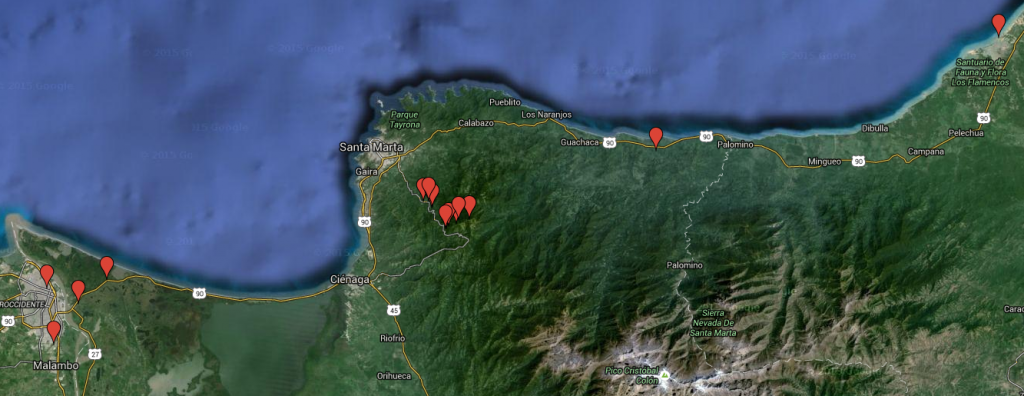I am not a fan of cold weather, so when winter arrives here in the northeast I love heading to tropical climates to escape the frozen landscape and enjoy some warm weather birding. This year I decided to head to Colombia for the first time. Colombia hosts more bird species than any other country (>1,900 species!), but for many years was underbirded due to security issues. Although the US Department of State still issues warnings about where to go, what to do, and what NOT to do, things have stabilized substantially, and birders and birding tours are returning to Colombia. In the next few posts I will try to relay impressions from my first birding trip to Colombia.

A map of the locations that we visit on this trip. Click on the image to access the Google map and to get details of each tagged location.
But perhaps it would be helpful to begin with some broad information and what we tried to do. To get a sense of perspective, Colombia is a relatively large country, slightly larger than Texas and California combined, and 4x as large as Ecuador. In addition, it is bisected by three arms of the northern Andes (the eastern, western, and central cordilleras) each separated by wide valleys, and also contains coastline on both the Pacific and Atlantic Oceans, expansive high plains (the Llanos), Amazonian lowlands, and the world’s highest coastal mountain range (the Sierra Nevada range) that is separate from the Andes. This size and geographical diversity results in biological diversity, but also creates difficulty for visitors who try to cover too much territory in too little time. So how does a birder cover all that terrain? The big name commercial birding tours that focus on maximum species numbers try to sample much of the country in a single tour, usually over a two-to-three week time frame, with lots of travel time interspersed with relatively short birding stops. That exhausting and frantic pace is not my kind of birding. So instead, my friend Pete and I decided to cover a relatively small area at a more leisurely pace, focusing on the coastal Sierra Nevada range. Commercial birding tours often offer this region as a six day extension, but we decided to cover the same area in a more leisurely twelve day time frame. We contacted Sebastian Ballesteros, a local freelance birder/guide/photographer who along with his brother David runs a small hostel and nature preserve called Faunal, located a few short miles above the town of Minca. Sebastian agreed to guide us for about half of the days and to leave us to bird by ourselves on the other days, resulting in a nice combination of guided and solo birding. Sebastian speaks English very well, which was a great help for two Americans who speak muy poquito Spanish, and provided excellent service. Our version of the ‘Santa Marta extension’ begins in Barranquilla on the Atlantic coast, we’ll spend nearly a week at different altitudes proceeding along the long rugged rocky road that climbs up from Minca to the San Lorenzo Ridge in pursuit of Santa Marta endemics, we’ll return back to the coast to bird in the dry scrub of the Guajira region, and then return for a few relaxing days in low dry forest and a final afternoon in Bogota.
Today we left behind the massive storm that delivered ~22 inches of snow to NJ a few days ago. The timing was fortunate, since there was enough time to clear away the snow and the backlog of flights, and our flights were not delayed. We caught some sleep during a long layover in the Bogota airport, and arrived in sunny Barranquilla ready for some tropical birding.
Next post: Let the birding begin.
